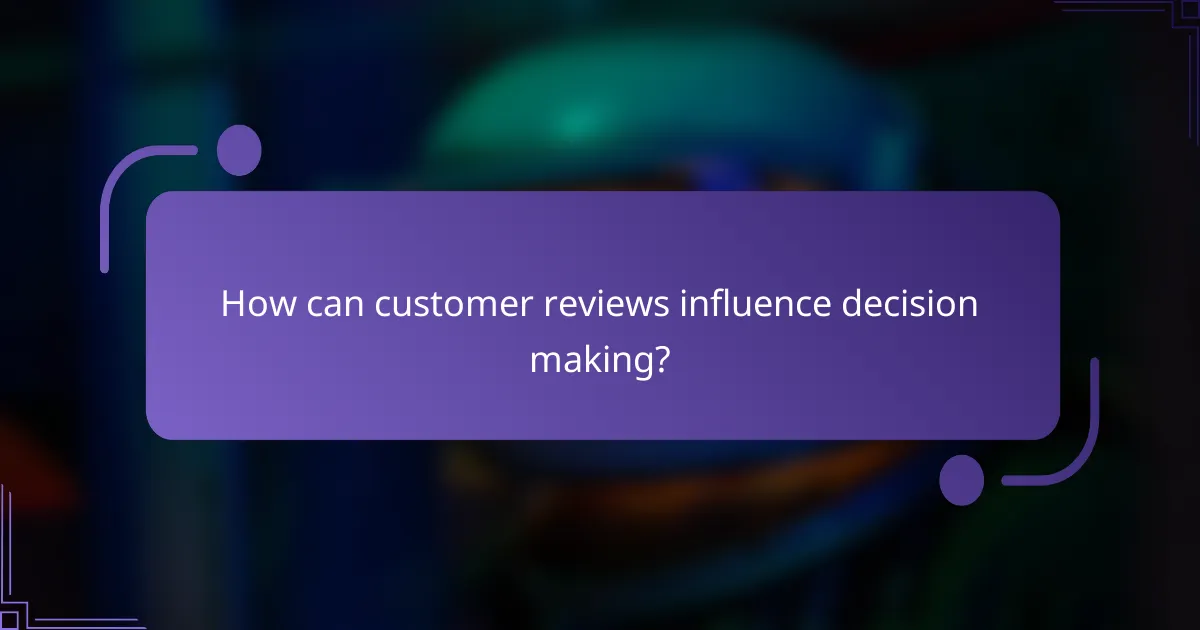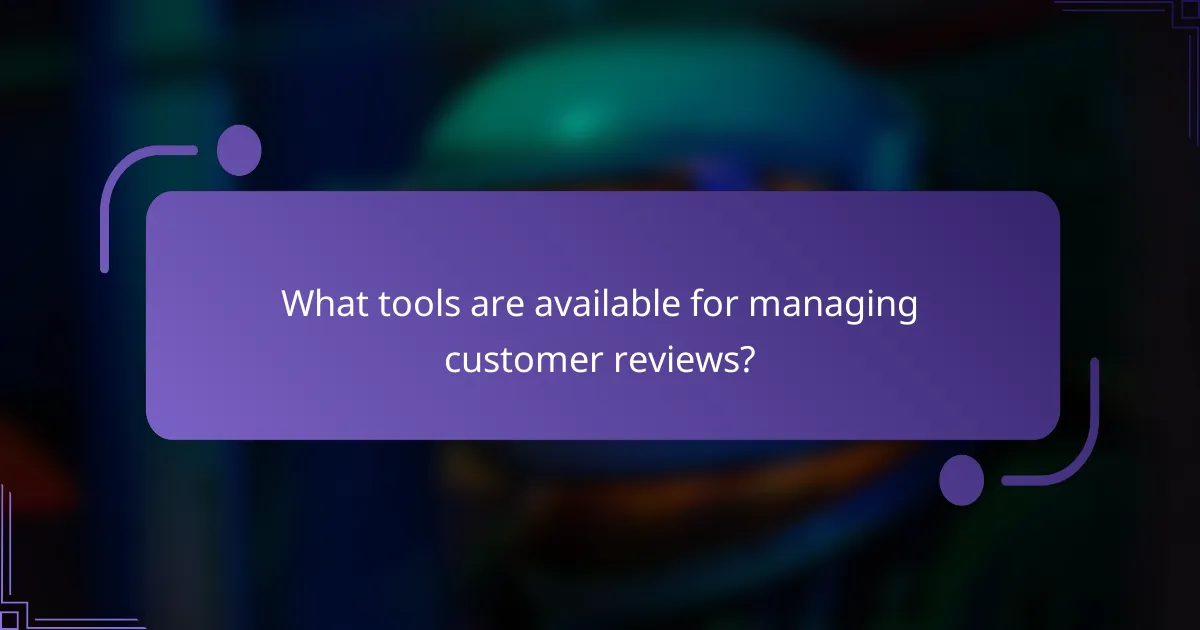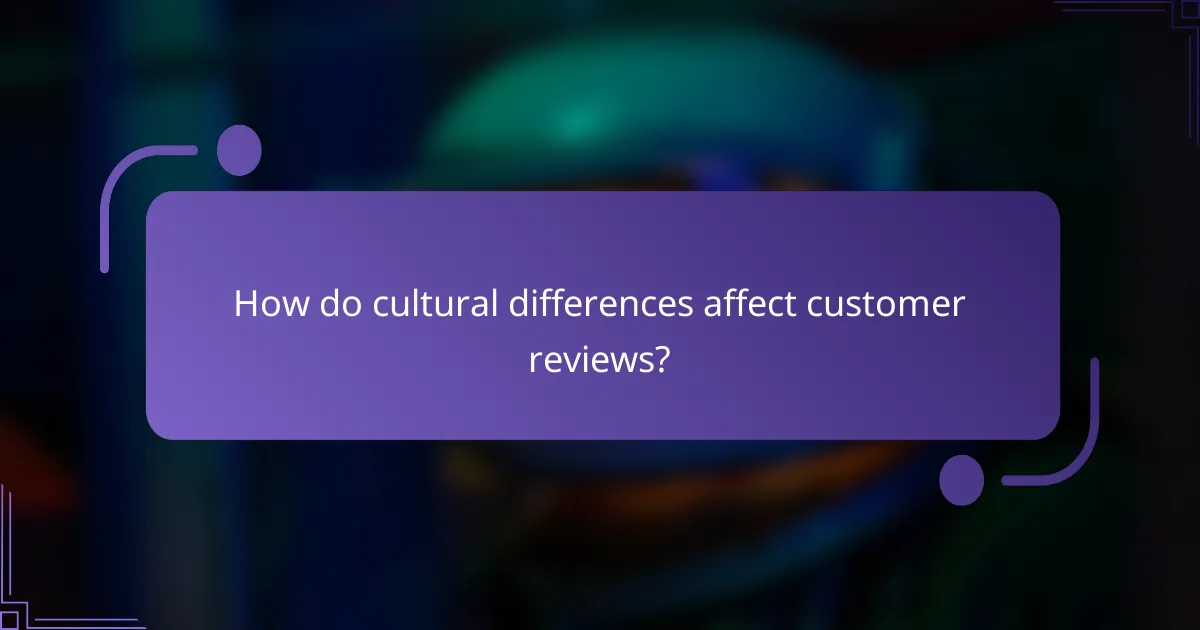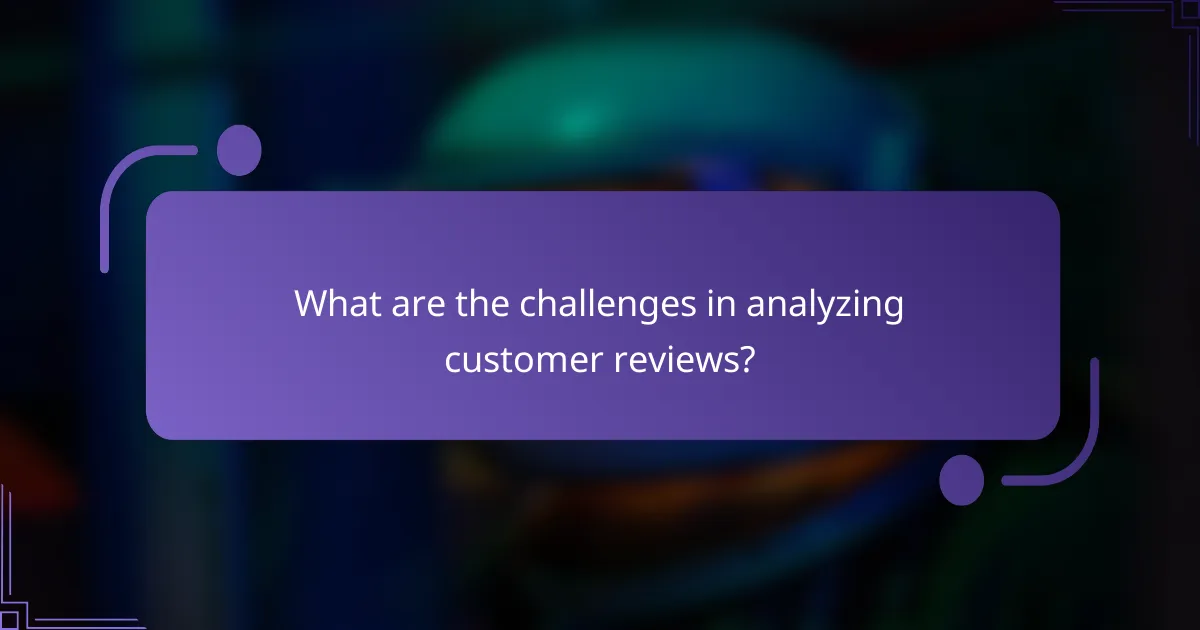Customer reviews play a crucial role in shaping consumer perceptions and influencing purchasing decisions. By analyzing these reviews, businesses can gain valuable insights into product quality and customer satisfaction, enabling them to make informed choices that enhance their offerings and marketing strategies.

How can customer reviews influence decision making?
Customer reviews significantly influence decision making by shaping perceptions and guiding choices. They provide insights into product quality and service reliability, often swaying potential buyers towards or away from a purchase.
Impact on consumer trust
Customer reviews play a crucial role in building consumer trust. Positive feedback can enhance credibility, while negative reviews may raise red flags. Many consumers rely on reviews as a primary source of information, often considering them more trustworthy than brand advertisements.
To foster trust, businesses should encourage genuine reviews and respond to feedback. Engaging with customers can demonstrate commitment to quality and customer satisfaction, further solidifying trust in the brand.
Effect on purchase behavior
Reviews can significantly alter purchase behavior by influencing consumers’ decisions at various stages of the buying process. A high rating can lead to increased sales, while a low rating may deter potential buyers. Research indicates that a majority of consumers read reviews before making a purchase, highlighting their importance.
To leverage this effect, businesses should actively manage their online reputation. Encouraging satisfied customers to leave positive reviews can create a favorable impression and drive sales, while addressing negative feedback promptly can mitigate damage.
Role in brand perception
Customer reviews shape brand perception by reflecting the experiences of previous buyers. A brand associated with positive reviews is often viewed favorably, while consistent negative feedback can tarnish its image. This perception can influence not only individual purchases but also long-term brand loyalty.
Brands should monitor reviews to understand consumer sentiment and make necessary adjustments. Highlighting positive reviews in marketing materials can enhance brand image, while addressing common complaints can improve overall customer satisfaction and perception.

What are effective strategies for interpreting customer reviews?
Effective strategies for interpreting customer reviews involve analyzing sentiment, identifying recurring themes, and evaluating the credibility of the reviews. These approaches help businesses gain insights into customer experiences and make informed decisions based on feedback.
Sentiment analysis techniques
Sentiment analysis techniques involve using algorithms or manual methods to determine the emotional tone of customer reviews. This can include categorizing reviews as positive, negative, or neutral based on keywords and phrases. Tools like natural language processing (NLP) can automate this process, allowing businesses to quickly gauge overall customer sentiment.
For practical application, consider using a simple scoring system where positive reviews score above a certain threshold, while negative ones fall below it. This can help in prioritizing areas for improvement or highlighting successful aspects of a product or service.
Identifying common themes
Identifying common themes in customer reviews requires careful reading or the use of text analysis tools to extract frequently mentioned topics. Look for patterns in feedback regarding product features, customer service, or pricing. This can reveal what customers value most and what issues need addressing.
Utilizing a thematic analysis approach can be beneficial. For example, categorize reviews into groups such as “quality,” “service,” and “value for money.” This will help in understanding which aspects resonate with customers and which may require enhancement.
Evaluating review credibility
Evaluating the credibility of customer reviews is crucial to ensure that the insights drawn are reliable. Check for indicators such as verified purchase status, the reviewer’s history, and the balance of positive and negative feedback. Reviews that are overly positive or negative without substantial detail may warrant further scrutiny.
Consider implementing a system to flag suspicious reviews, such as those that are excessively vague or use similar language. This can help maintain the integrity of the feedback you rely on for decision-making. Additionally, cross-referencing reviews across multiple platforms can provide a more comprehensive view of customer sentiment.

How can businesses leverage customer reviews for growth?
Businesses can effectively leverage customer reviews to drive growth by analyzing feedback to improve products, enhance customer service, and refine marketing strategies. By understanding customer sentiments and preferences, companies can make informed decisions that align with market demands.
Enhancing product development
Customer reviews provide valuable insights into product performance and user experience. By systematically analyzing feedback, businesses can identify common issues and desired features, allowing them to prioritize enhancements or new developments. For instance, if multiple reviews mention a lack of durability, a company can focus on improving materials in future iterations.
To effectively utilize reviews for product development, consider categorizing feedback into themes such as functionality, design, and usability. This structured approach helps in pinpointing specific areas for improvement and innovation.
Improving customer service
Customer reviews often highlight strengths and weaknesses in service delivery. By monitoring feedback, businesses can identify recurring service issues and address them promptly, leading to higher customer satisfaction. For example, if reviews frequently mention long wait times, a company might consider staffing adjustments or process improvements.
Encouraging customers to leave reviews can also foster a sense of community and engagement. Responding to reviews, whether positive or negative, demonstrates that a business values customer input and is committed to continuous improvement.
Boosting marketing efforts
Customer reviews can significantly enhance marketing strategies by providing authentic testimonials that build trust with potential customers. Highlighting positive reviews in promotional materials or on social media can attract new clients and reinforce brand loyalty among existing ones.
Additionally, businesses should consider using review data to tailor marketing messages. Analyzing which features customers appreciate most can guide advertising focus, ensuring that campaigns resonate with target audiences. For example, if reviews emphasize excellent customer support, a company can feature this aspect prominently in its marketing efforts.

What tools are available for managing customer reviews?
Several tools can help businesses effectively manage customer reviews, enhancing their online reputation and customer engagement. These platforms streamline the collection, monitoring, and response processes, making it easier to leverage customer feedback for business growth.
Trustpilot for review collection
Trustpilot is a popular platform for gathering customer reviews, allowing businesses to invite customers to share their experiences. By sending automated review requests via email after a purchase, companies can increase the volume of feedback received, which is crucial for building trust.
Consider using Trustpilot’s features like customizable review invitations and the ability to showcase reviews on your website. This can enhance credibility and encourage potential customers to choose your services.
Google My Business for local visibility
Google My Business (GMB) is essential for businesses aiming to improve their local visibility through customer reviews. By claiming and optimizing your GMB listing, you can encourage customers to leave reviews directly on Google, which can significantly impact local search rankings.
To maximize GMB’s effectiveness, regularly respond to reviews and keep your business information updated. This engagement not only boosts your online presence but also fosters customer loyalty.
Yelp for service-based businesses
Yelp is particularly beneficial for service-oriented businesses, as it allows customers to share detailed experiences and ratings. A strong Yelp presence can attract new clients, especially in industries like restaurants, home services, and personal care.
To succeed on Yelp, actively manage your profile by responding to reviews and updating your business information. Consider running promotions or special offers to encourage satisfied customers to leave positive feedback, enhancing your overall reputation on the platform.

How do cultural differences affect customer reviews?
Cultural differences significantly influence customer reviews, shaping how feedback is expressed and interpreted. Variations in language, expectations, and feedback styles can lead to diverse perceptions of the same product or service across different regions.
Variations in review language
The language used in customer reviews can vary widely based on cultural context. For example, some cultures may favor direct and concise language, while others might prefer more elaborate and descriptive expressions. This can affect how reviews are perceived; a straightforward review might be seen as honest in one culture but overly blunt in another.
Additionally, idiomatic expressions and local slang can create misunderstandings. Businesses should be aware of these linguistic nuances when analyzing reviews from different regions to avoid misinterpretation of customer sentiments.
Impact of regional expectations
Regional expectations play a crucial role in shaping customer reviews. In some cultures, customers may expect a high level of service and express dissatisfaction more vocally when these expectations are not met. Conversely, in cultures where feedback is often reserved, negative reviews may be less frequent but can carry significant weight when they do occur.
Understanding these expectations can help businesses tailor their customer service strategies. For instance, companies operating in high-expectation regions might focus on enhancing service quality to meet or exceed customer demands.
Differences in feedback styles
Feedback styles differ significantly across cultures, influencing how customers articulate their experiences. Some cultures encourage constructive criticism, leading to detailed reviews that provide specific suggestions for improvement. Others may prefer to highlight positive aspects, resulting in more favorable but less detailed feedback.
Businesses should consider these differences when evaluating reviews. For example, a high number of positive reviews in a culture that typically provides detailed feedback might indicate a genuine endorsement, while a lack of detailed negative reviews could suggest a reluctance to criticize openly.

What are the challenges in analyzing customer reviews?
Analyzing customer reviews presents several challenges, including the prevalence of fake reviews and the impact of biased feedback. These issues can skew insights and lead to poor decision-making if not addressed properly.
Handling fake reviews
Fake reviews can significantly distort the perception of a product or service. They may be posted by competitors or individuals with ulterior motives, making it crucial to identify and filter them out. Look for patterns such as repetitive language, suspiciously high ratings without detailed comments, or reviews that appear in clusters.
To mitigate the impact of fake reviews, consider employing automated tools that analyze review patterns and flag anomalies. Additionally, encourage verified purchases to leave feedback, as this can help ensure authenticity.
Dealing with biased feedback
Biased feedback often arises from extreme experiences, whether positive or negative, leading to an unbalanced view of a product. This can result in overemphasis on certain features while ignoring others. It’s essential to recognize that a few vocal customers may not represent the broader user base.
To counteract bias, analyze a larger sample of reviews and look for trends rather than focusing on outliers. Consider categorizing feedback into themes to gain a more comprehensive understanding of customer sentiment. Engaging with customers for follow-up insights can also provide a fuller picture of their experiences.
